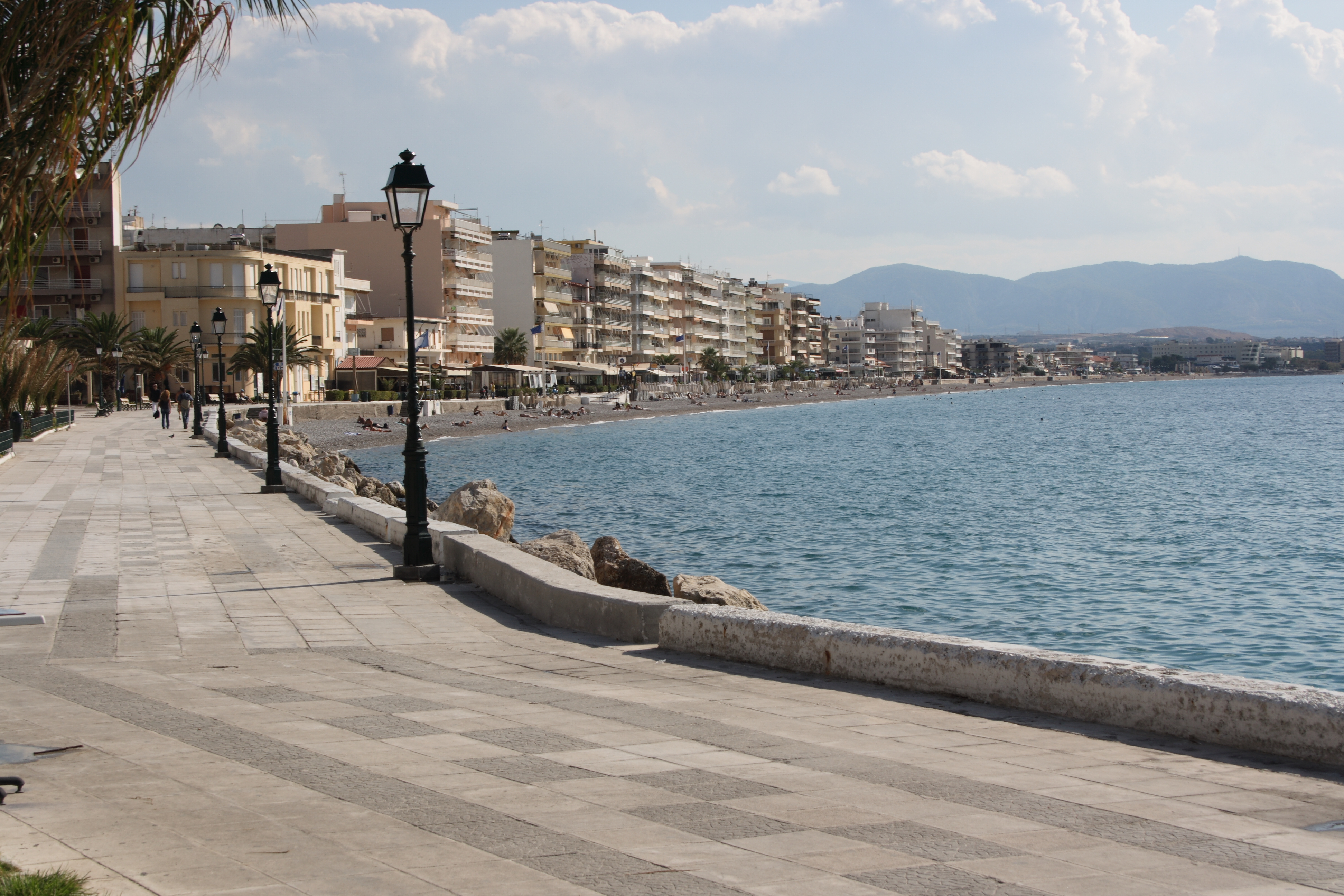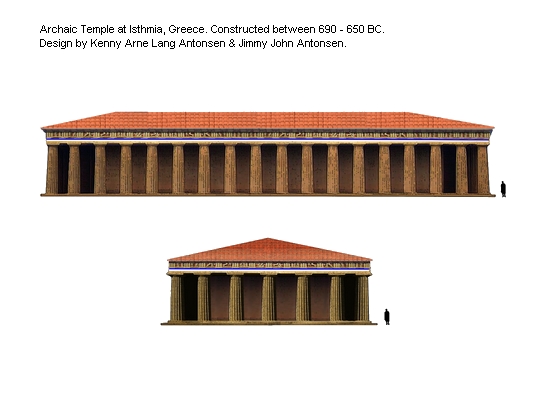|
Isthmia, Corinthia
Isthmia ( el, Ισθμία) is a Greek village and community 7.5 km southeast of Corinth. It is located in the south entry of Corinth Canal. The community spreads in the place where the Isthmian Games were held in antiquity. So, near the village important ruins of the archaeological site are kept including the Temple of Poseidon, the ancient stadium and the ancient theatre. Administravely, Isthmia belongs to Loutraki-Perachora-Agioi Theodoroi municipality and Loutraki-Perachora municipal unit. Description Isthmia is located in an area where the Isthmian Games were held. The Isthmian Games started in 582 BC and finished during 5th century AD. In modern times, Isthmia was a small village. But after the digging of Corinth Canal between 1880 and 1893 the village developed. Today it is a community, including five settlements Isthmia, Kyras Vrysi, Kalamaki, Paradeisos, Agios Charalampos and Kavos. The population of the village Isthmia is 1,134 inhabitants and the population of the ... [...More Info...] [...Related Items...] OR: [Wikipedia] [Google] [Baidu] |
Peloponnese (region)
The Peloponnese Region ( el, Περιφέρεια Πελοποννήσου, translit=Periféria Peloponnísou, ) is a Modern regions of Greece, region in southern Greece. It borders Western Greece to the north and Attica (region), Attica to the north-east. The region has an area of about . It covers most of the Peloponnese peninsula, except for the northwestern subregions of Achaea and Elis (regional unit), Elis which belong to Western Greece and a small portion of the Argolis, Argolid peninsula that is part of Attica (region), Attica. Administration The Peloponnese Region was established in the 1987 administrative reform. With the 2011 Kallikratis plan, its powers and authority were redefined and extended. Along with the Western Greece and Ionian Islands (region), Ionian Islands regions, it is supervised by the Decentralized Administration of Peloponnese, Western Greece and the Ionian, Decentralized Administration of Peloponnese, Western Greece and the Ionian Islands based at P ... [...More Info...] [...Related Items...] OR: [Wikipedia] [Google] [Baidu] |
Corinthia
Corinthia ( el, Κορινθία ''Korinthía'') is one of the regional units of Greece. It is part of the region of Peloponnese. It is situated around the city of Corinth, in the north-eastern part of the Peloponnese peninsula. Geography Corinthia borders on Achaea to the west and southwest, the Gulf of Corinth and Attica to the north, the Saronic Gulf to the east, Argolis to the south and Arcadia to the southwest. The Corinth Canal, carrying ship traffic between the Ionian and the Aegean seas, is about east of Corinth, cutting through the Isthmus of Corinth. Corinthia is increasingly seen as part of the wider metropolitan area of Athens, with municipalities, such as Agioi Theodoroi in the easternmost part of the regional unit, being considered suburbs of Athens. The area around Corinth and the western Saronic including the southeastern part are made up of fault lines including the Corinth Fault, the Poseidon Fault and a fault running from Perahcora to Agioi Theodoroi. M ... [...More Info...] [...Related Items...] OR: [Wikipedia] [Google] [Baidu] |
Loutraki-Perachora-Agioi Theodoroi
Loutraki-Perachora-Agioi Theodoroi ( el, Λουτράκι-Περαχώρα-Άγιοι Θεόδωροι) is a municipality in the Corinthia regional unit, Peloponnese, Greece. The seat of the municipality is the town Loutraki. The municipality has an area of 294.90 km2. The municipality was formed at the 2011 local government reform by the merger of the former municipalities Agioi Theodoroi and Loutraki-Perachora Loutraki-Perachora (Greek: Λουτράκι-Περαχώρα) is a former municipality in Corinthia, Peloponnese, Greece. Since the 2011 local governmental reform it is part of the municipality Loutraki-Perachora-Agioi Theodoroi, of which it is a ..., that became municipal units. Initially named ''Loutraki-Agioi Theodoroi'', in January 2014 the municipality was renamed ''Loutraki-Perachora-Agioi Theodoroi''. References Municipalities of Peloponnese (region) Populated places in Corinthia {{Peloponnese-geo-stub ... [...More Info...] [...Related Items...] OR: [Wikipedia] [Google] [Baidu] |
Loutraki-Perachora
Loutraki-Perachora (Greek: Λουτράκι-Περαχώρα) is a former municipality in Corinthia, Peloponnese, Greece. Since the 2011 local governmental reform it is part of the municipality Loutraki-Perachora-Agioi Theodoroi, of which it is a municipal unit. The municipal unit has an area of 196.870 km2. The region of Loutraki-Perachora is a tourist destination for summer and weekend visitors from the Athens metropolitan area, due to its proximity (about 80 km) and the clean and sandy beaches surrounding the town of Loutraki and other seaside settlements. The area is also famous for the Heraion of Perachora (sanctuary of the goddess Hera), an archaeological site of significance located at the end of the Perachora peninsula. Loutraki Loutraki, the most important settlement and the seat of the municipality, is a seaside town with a population of 11,564 inhabitants (2011 census), known for its natural environment, spas and mineral water springs. Recently one of the big ... [...More Info...] [...Related Items...] OR: [Wikipedia] [Google] [Baidu] |
Submersible Bridge
A submersible bridge is a type of movable bridge that lowers the bridge deck below the water level to permit waterborne traffic to use the waterway. This differs from a lift bridge or table bridge, which operate by raising the roadway. Two submersible bridges exist across the Corinth Canal in Greece, one at each end, in Isthmia and Corinth. They lower the centre span to 8 metres below water level when they give way to ships crossing the channel. The submersible bridge's primary advantage over the similar lift bridge is that there is no structure above the shipping channel and thus no height limitation on ship traffic. This is particularly important for sailing vessels. Additionally, the lack of an above-deck structure is considered aesthetically pleasing, a similarity shared with the Chicago-style bascule bridge and the table bridge. However, the presence of the submerged bridge structure limits the draft of vessels in the waterway. The term ''submersible bridge'' is also somet ... [...More Info...] [...Related Items...] OR: [Wikipedia] [Google] [Baidu] |
Corinth
Corinth ( ; el, Κόρινθος, Kórinthos, ) is the successor to an ancient city, and is a former municipality in Corinthia, Peloponnese, which is located in south-central Greece. Since the 2011 local government reform, it has been part of the municipality of Corinth, of which it is the seat and a municipal unit. It is the capital of Corinthia. It was founded as Nea Korinthos (), or New Corinth, in 1858 after an earthquake destroyed the existing settlement of Corinth, which had developed in and around the site of ancient Corinth. Geography Located about west of Athens, Corinth is surrounded by the coastal townlets of (clockwise) Lechaio, Isthmia, Kechries, and the inland townlets of Examilia and the archaeological site and village of ancient Corinth. Natural features around the city include the narrow coastal plain of Vocha, the Corinthian Gulf, the Isthmus of Corinth cut by its canal, the Saronic Gulf, the Oneia Mountains, and the monolithic rock of Acrocorinth ... [...More Info...] [...Related Items...] OR: [Wikipedia] [Google] [Baidu] |
Corinth Canal
The Corinth Canal ( el, Διώρυγα της Κορίνθου, translit=Dhioryga tis Korinthou) is an artificial canal in Greece, that connects the Gulf of Corinth in the Ionian Sea with the Saronic Gulf in the Aegean Sea. It cuts through the narrow Isthmus of Corinth and separates the Peloponnese from the Greek mainland, arguably making the peninsula an island. The canal was dug through the Isthmus at sea level and has no locks. It is in length and only 24.6 metres (80.7 feet) wide at sea level, making it impassable for many modern ships. It is currently of little economic importance and is mainly a tourist attraction. The canal was initially proposed in classical times and a failed effort was made to build it in the 1st century AD. Construction recommenced in 1881 but was hampered by geological and financial problems that bankrupted the original builders. It was completed in 1893, but, due to the canal's narrowness, navigational problems, and periodic closures to repair land ... [...More Info...] [...Related Items...] OR: [Wikipedia] [Google] [Baidu] |
Isthmian Games
Isthmian Games or Isthmia (Ancient Greek: Ἴσθμια) were one of the Panhellenic Games of Ancient Greece, and were named after the Isthmus of Corinth, where they were held. As with the Nemean Games, the Isthmian Games were held both the year before and the year after the Olympic Games (the second and fourth years of an Olympiad), while the Pythian Games were held in the third year of the Olympiad cycle. Origin The Games were reputed to have originated as funeral games for Melicertes (also known as Palaemon), instituted by Sisyphus, legendary founder and king of Corinth, who discovered the dead body and buried it subsequently on the Isthmus. In Roman times, Melicertes was worshipped in the region. Another likely later myth held that Theseus, legendary king of Athens, expanded Melicertes' funeral games from a closed nightly rite into fully-fledged athletic-games event which was dedicated to Poseidon, open to all Greeks, and was at a suitable level of advancement and popularity ... [...More Info...] [...Related Items...] OR: [Wikipedia] [Google] [Baidu] |
Temple Of Isthmia
The Temple of Isthmia is an ancient Greek temple on the Isthmus of Corinth dedicated to the god Poseidon and built in the Archaic Period. It is about east of ancient Corinth, at the site of ancient Isthmia. It appears to have been constructed in the seventh century BC though was later destroyed in 470 BC and rebuilt as the Temple of Poseidon at Isthmia in c. 440 BC during the Classical period. History Around the turn of the 8th to 7th century BC, it is apparent that there is the emergence of a new period in both Greek architectural and artistic history. Corinth was at the centre of this with its development of new pottery design, settlement planning, military organisation and most significantly being the possible birthplace of monumental buildings and a new style of architecture known as the Doric order. The date of the Archaic temple’s construction is important then as it establishes when monumental architecture began as well as when the transition from Iron Ag ... [...More Info...] [...Related Items...] OR: [Wikipedia] [Google] [Baidu] |



